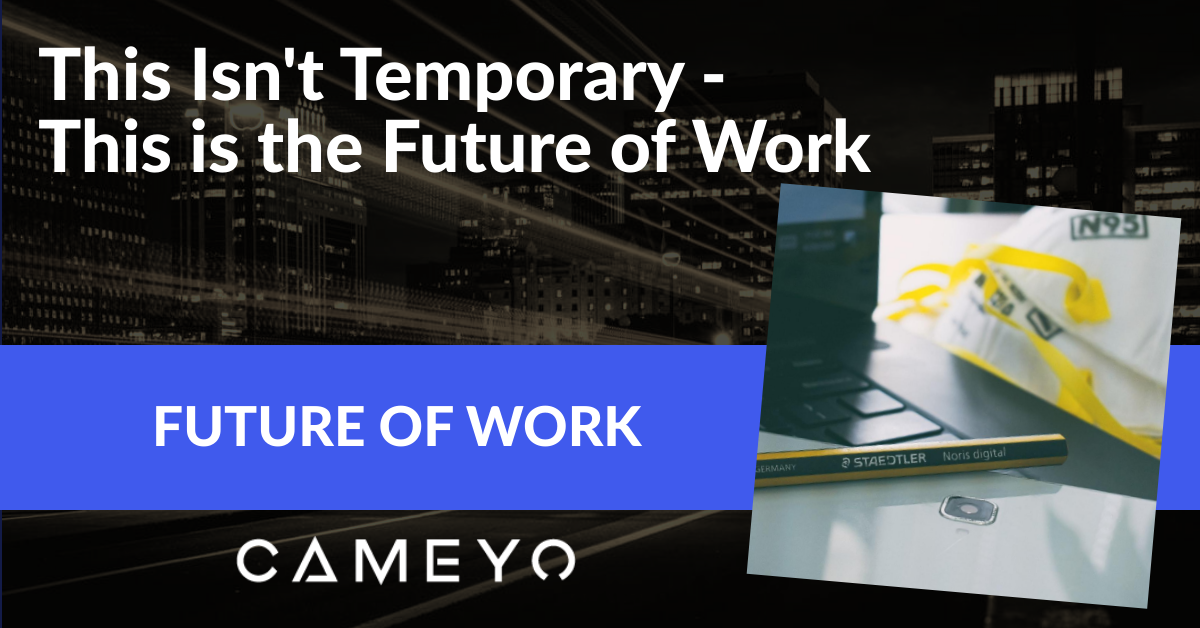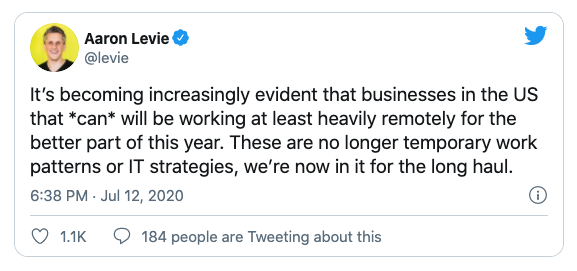As many locations around the world experience a resurgence in COVID-19 cases, a simple truth has become even more evident:
Everything that we’re currently experiencing when it comes to remote work can no longer be viewed as a temporary situation. Companies need to transition to long-term, scalable solutions that will enable their people to continue to be productive from anywhere, on any device.
In other words – the “future of work”, which people have been discussing for years, is here now.
Rethinking the “Office”

And it’s not just large companies that are making the move to long-term (or permanent) remote work. A recent CNBC headline puts it bluntly – “Tech companies are ending leases and consolidating offices as remote work is here to stay.”
The article dives into the topic of real-estate costs, and how companies of all sizes are realizing that those are costs that can easily be reduced or eliminated. The article notes:
“In the tech hubs of Seattle, Silicon Valley, New York and elsewhere, many CEOs are coming to the same conclusion — real estate is not a worthwhile expense. Start-ups that never intended to be fully distributed are letting leases end or looking for ways to get out of longer deals, while bigger employers are closing facilities, consolidating space and exploring ways to provide workers with flexible arrangements and options closer to home to avoid long commutes.”
From startups looking to extend their runway by saving money on rent to larger companies looking to ensure the safety and health of their employees – it’s clear that the future of work requires companies to rethink their relationship with physical office spaces.
Accelerating the Transition to the Cloud
In this recent interview that Eric Yuan, CEO of Zoom, did with Gregg Lemkau of Goldman Sachs, Yuan succinctly highlights several key issues when it comes to how companies need to prepare for the new future of work:
“Now that almost everyone is working from home, this has accelerated everyone’s transition to the cloud.
Also, a lot of our products will evolve to support working from home. Because when we all had to go to our homes to work, we realized – we are not ready. Because sometimes the device at home is not a corporate device – not to mention, a lot of applications we cannot access. We have to use VPNs. So that does not work. That’s not scalable.
I think a lot of the services we use today will be evolved to completely embrace the use cases where every user might work from home. So these two things – application experience and the cloud transition – those two will be the drivers in the next several years.”
Yuan hits on a few very interesting points in this short clip, all of which we agree with:
- Products need to evolve to support people working from home on devices that are not corporate owned
- There are a lot of applications that people simply cannot access from home
- VPNs are problematic and do not scale
The Rise of Digital Workspace
Yuan’s first two points succinctly highlight the explosive growth in the adoption of Digital Workspaces. Digital Workspaces enable companies to give their people a single, seamless portal to access all of the business-critical applications and information they need to be productive from anywhere, on any device. The overall concept of Digital Workspaces is not new – but they have certainly been thrust into the limelight because of this pandemic.
Digital Workspaces like Cameyo solve the application accessibility issue that Yuan discusses, while also enabling secure access to all of those apps on any device – including personal, non-IT managed devices. This enables IT to separate the business-critical applications their people need access to from the user’s actual device by making those apps available on any device, from the browser. No malware or security issues on the user’s machine ever has access to the corporate network since those devices no longer need to connect via VPN.
The Demise of the VPN
When it comes to Yuan’s third point, he echoes a sentiment that has been getting more and more attention recently, which is the fact that VPNs simply were not built for widespread remote work, and cannot scale. We’ve discussed this in depth (see “Why VPNs are not the solution for Remote Work”), but the crux of the issue is that:
- VPNs introduce a significant security risk when people are connecting from personal, non-IT managed devices.
- VPNs create a bottleneck issue, and increasing capacity is often cost-prohibitive for many companies.
- VPNs provide a poor user experience that hinders productivity.
This is where Cameyo’s NoVPN technology comes into play. Cameyo NoVPN empowers organizations to give all of their remote workers secure access to internally-hosted web apps without requiring a VPN. This enables organizations to give remote workers secure access to Windows desktop and Intranet web apps from behind the corporate firewall without the cost and user-experience compromise of VPNs so that people can access business-critical applications from anywhere in the world just as productively as if they were in the office.
Conclusion
The “future of work” has long been a favorite topic of tech pundits to speculate on and discuss. But this pandemic has accelerated everything. This is no longer speculation – the future of work is here now, and the “new normal” is one where every company must enable every employee to be securely productive from any device, anytime. If you’re looking for a Digital Workspace partner who can help get you up and running quickly with a cloud-native solution that was built to scale, we’d love to discuss. You can get started with a free trial today and you’ll be up and running in minutes, and our team will be happy to provide a demo and answer any questions you may have.

